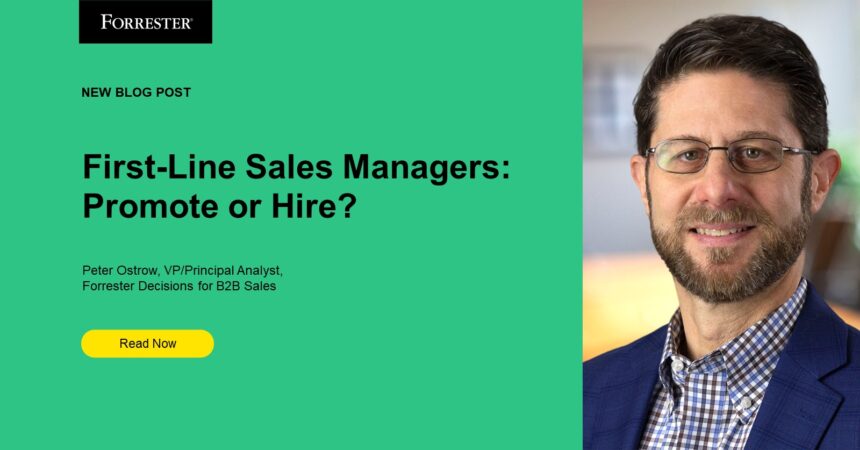Today Forrester is publishing new research revealing that, all else being equal, B2B sales leaders achieve better revenue results when they hire first-line sales managers (FLSMs) externally, rather than promoting individual contributors (ICs). This runs counter to standard practice and tradition, but the data is clear: Externally hired managers and their teams perform better. Our advice in the report, however, is more nuanced: Revenue leaders who staff FLSMs the right way, not the easy way, produce the best results. Let’s look at four real-world scenarios.
Illumio: Growth Requires Fresh Eyes
Mat Hill of Illumio says, “I’ve seen firsthand what happens when organizations default to moving top achievers into manager roles. Assuming rep skills translate into management success often fails spectacularly.” Mat explains that, in addition to presuming that inside familiarity creates smoother rep-to-manager transitions, sales leaders create echo chambers when failing to bring fresh, external perspectives into the FLSM tier: “When you use who you have, instead of who you need — especially in high-growth environments — you handicap most evolution as a revenue team.”
Illumio hires more than 90% of sales managers externally, both because of these factors and due to the constantly changing cybersecurity industry: “We need the kind of outside-in objectivity that only comes with fresh, clear eyes.” Additionally, Illumio views the FLSM role as an on-ramp for future leadership, and “managing your own activities and outcomes is starkly different from leading those of others.” To support the influx of newly hired managers, Mat’s team provides significant onboarding and developmental opportunities specific to the FLSM role, emphasizing leadership as a core competency rather than a rudimentary “just go hit quota” enablement mindset.
Planview: No Inside Tracks To Management
Penny Springer is VP of global enablement at Planview, where the dramatic differences between selling and managing are recognized by most ICs. As a result, “Only a minority of our FLSM roles are filled internally, but those who are promoted go through the same, rigorous application and interview process as external hires. There’s no corner-cutting or inside track; that would diminish any new manager’s success.” Penny finds that external hires “bring more of a growth mindset, ready-made coaching skills, consistency, maturity, and adaptability,” and the company then builds on these competencies with FLSM-specific enablement such as coaching the coach, roleplay, technology, strategic selling, and more. “Enabling managers is far from an afterthought here,” she explains. “Our team spends about 30% of our time supporting FLSMs specifically,” and managers accessing the most revenue enablement resources generally produce the most revenue.
OutSystems: Honesty Is the Best Policy
Nevertheless, we hear from Ben Harris, director of field success and enablement at OutSystems that “[h]iring managers from within always sends a positive message for career-pathing to the greater employee community; it’s hard to oversell how valuable institutional knowledge can be when promoting northward into the org chart.” But Outsystems insists on holding objective, candid conversations with all ICs expressing interest in management. When ICs express interest in moving into management, there is a frank discussion about the difference between eligibility (having sold a lot of products) and qualification (possessing true FLSM competencies), and ICs are then presented with development plans that can lead to multiple outcomes, with promotion to manager being only one of them. “No organization should even consider promoting an IC to a manager without a solid development plan in place,” Ben says. “The worst thing you can do to a strong individual performer is promote them without preparing them.” Ben’s enablement team supports revenue leaders in structuring objective discussions with reps about their development, like when to acknowledge that an FLSM promotion isn’t the best fit and how to keep unpromoted sellers engaged with mentoring, learning, and “for the greater good” contributions. “Being able to say, ‘We love you in the role you’re in, and here’s how we’re going to amplify its benefits for us both,’” Ben concludes, generally yields a win-win outcome for all involved parties.
ADP: Two Birds, One Stone
Ben’s message about positive internal signals is illustrated by some historical adaptations at ADP. Chuck Marcouiller spent 20 years in sales leadership and developing sales leaders for the payroll giant, which in the early 2000s was sourcing 52% of FLSMs from IC ranks — considered unacceptably low — and experiencing huge churn among frustrated ICs. “We couldn’t keep losing our top sellers after only 2.5 years’ average contribution,” Chuck explains, “so we embarked on an internal pipeline development program to solve both issues at once.” Sellers with proven quota attainment success and VP sponsorship were provided with passive, virtual training; then, live multiday leadership development with executive access; and, finally, hands-on project training culminating in formally presenting both their deliverables and potential as leaders. ICs passing this threshold were certified as ready for sales leadership and could bypass the first interview round within internal posting processes. This provided ICs with clear insight into a potential FLSM promotion (some came to realize that it wasn’t right for them) and ADP with what Chuck calls “higher-quality candidates and much higher retention of all reps who participated in the program, no matter if they choose a leadership path or not.”
Forrester customers with access can view and download the report; we encourage all revenue enablement practitioners to discover what FLSM sourcing trends work best within their organization, and to maximize the funnel for those sales manager candidates most likely to succeed.







